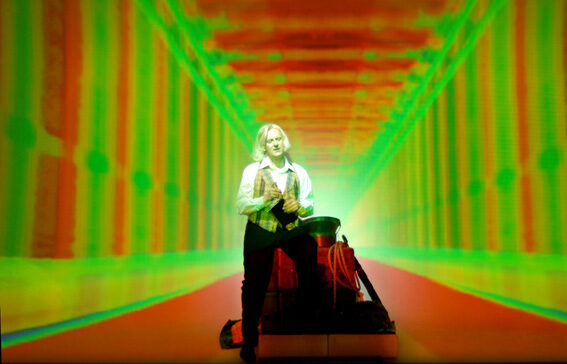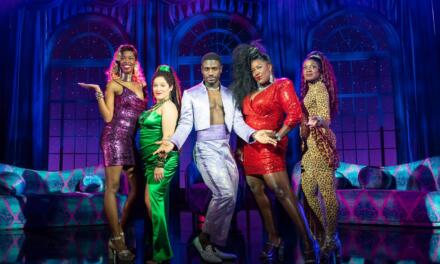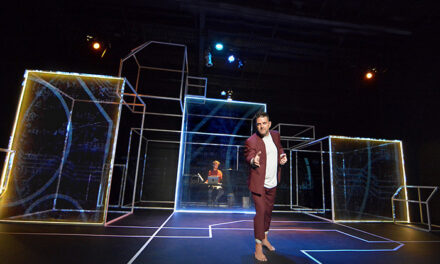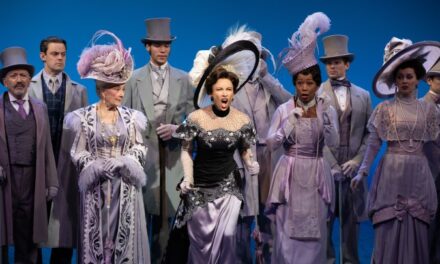In recent theatre practice, attempts have been made and desires expressly voiced–from puppet theatre to robotic, cyborg, hybrid and/or intermedial performance—to create pieces of theatre that defy the gravitational limitations of live presence. The flexibility of theatre forms and of “theatricalizeable” material has in many cases rendered the actor’s body nearly obsolete.
The extensive use of multimedia forms, besides “updating” theatre’s “polyphonic system of information” (Barthes), no doubt mirrors an instinct for self-preservation and brings to the fore ontological questions about the multiple facets of performativity in a post-humanist era. Furthering the understanding of the “text-ability” of any constituent element of the stage within the current postmodern, postdramatic paradigm, the paper dwells on the battle between a semiotically-bound self-reliant performance text as inscribed by technological simulacra and its phenomenological claim by the actor. The presentation focuses on examples taken from the multimedia work of Robert Lepage, Ivo van Hove, and the Wooster Group, exploring the tension experienced by both performers–and by extension, spectators—when faced with their screened/duplicated/“ghosted” selves. In these directors’ work, the implication often becomes that digitized representations of the self–and by extension of the world—are frequently the only valid, if counterfeit, realities in postmodern, “post-existential” culture.
The examples of Lepage, Van Hove, and the Wooster Group is significant in defining a landscape where the technologically-informed mise en scene actually reflects a kind of nostalgia for the individual’s “pure” corporeality, which has in our times been further and relentlessly problematized by a multitude of cultural metaphors. While it is certainly worth investigating the ways in which the combination of video and live images can become “a visual metaphor of split subjectivity” (Causey in Auslander: 2008, 386), it is equally important to consider the reasons and conditions that have rendered technological mediation in performance an increasingly vital partner in the representation of contemporary identity.
Addressing issues of identity and self-definition, auteur directors have relied on digital articulation to manufacture narratives that transcend the inbred constraints of the theater form. This involves engaging the aesthetic of the media that often combines live and mediated presence, recorded voice, and TV-like segmentation of story-telling. Efforts to compete against the speed of the moving image and to accelerate, annul, or blur time and space have resulted in the essential liveness of theater[1] becoming increasingly devalued or irrelevant. While the abundance of intermedial practices suggests that we are way past the stage of demonizing the binary trajectory of the “real” and the virtual, the anxiety of immateriality and fragmentation generates a sense of nostalgia that is both attractive and unnerving. If actors can be pixels or cyborgs (thus, posthuman), is our own outlook on identity postexistential? Are we becoming less real ourselves by virtue of our fascination with all those multiple versions of “character” and “self” in performance, which in effect reflect our own potential “multipliability”?
The work of The Wooster Group, Ivo van Hove, and Robert Lepage has consistently collapsed hierarchical definitions of meaningfulness, recalibrating phenomenological notions of presencing. In their productions, constituent immediacies are revisited and compromised; the audience’s connection to the performer–well anticipated in more mainstream forms of representation–is subjected to the authoritative function of projections, recordings and visual framing, and, as a result, the critical distance between spectator and spectacle is carried through the performers’ estrangement from their own selves: quite often, they are in fact “bodies distanced in images, viewed as resources, lived as things to be seen, managed and mastered.”[2]
Well embedded into the tissue of acting, the duality between materiality-presence on the one hand, and on the other hand an “uncanny” (as it has been broadly described) condition that is both hyper-real and intangible, yet reproducible, both influence the performer’s construction of identity Faces and bodies are split, multiplied and manipulated at the director’s will, their subjectivity is extended, challenged and reconfigured.[3] Nostalgia occurs precisely at the point of loss of the so-called “authentic” self–the consequence of a competition between the actor’s live presence and its screened simulacrum. In dramaturgical terms, the onslaught of character deaths (a theoretical concept introduced by Elinor Fuchs in her seminal 1983 study), leaves behind a trail of tears for any such “carnal demise.” Yet, that bittersweet nostalgia is rather short-lived, given that our philosophical adjustment/reconciliation to the character’s reincarnation as a hybrid is immediate, drawn as we are into the character-performer’s state of liminality, an existence caught between corporeality and imagination.
“If there is any clear watershed,” argues Fuchs, between modern and postmodern in drama, it is that “postmodern normalizes and shrugs off as ‘merely conceptual’ the sense of terror (or novelty) associated with posthumanist thinking.”[4]
In the productions of LeCompte, Lepage and van Hove, technology does more than reflect or reinforce the alienation between stage and auditorium, or that between the live performer and the virtual world, created for and around her. Rather, the use of video screens, microphones, and live cameras adds a more complex compositional dimension to what is usually termed “visual dramaturgy.”
Liz LeCompte of The Wooster Group describes character as “an accumulation of fragments of which the performer is the initiator. The character is a ‘moment in stage time.’”[5]
For her, as also for Lepage and van Hove, the manner in which actors are layered or undermined through the addition of voice recordings, film footage, split-screen and/or montage, inadvertently involves the performer in the mechanics of “re-dramatizing” the character. A composite of the live and its electronic double, the actor is naturally a generator of action (as the very name suggests), and a site where meaning is inscribed. Thus, actors alternately create and receive/reflect narratives: they interpret through movement and presence, but also receive and respond to the projection or broadcast of impressions and structures that seem well beyond their control. Seen in this light, acting becomes the art of both doing and allowing things to be done.
Similarly, perceiving an intermedial performance as a spectator turns into a process of re-writing the characters’ essential narrative, by resolving the conflict between the characters-performers’ actual and virtual selves and ultimately saluting their convergence as necessary and liberating. Commanding moderators of identity, plasma television screens and microphones on metal stands abound in the multimedia art of The Wooster Group, where the performers demonstrate the work of acting amid objects of technology, which heighten, distort or sabotage both the actor’s and the character’s fundamental selfhood. The company’s productions To You, the Birdie (2002) and Hamlet (2007) subvert and fragment the actors’ presence on stage, constructing “consciously inauthentic bodies in performance” (Monks in Mitter and Shevtsova 207), while their high-pitched, interceded voices convey a sense of distance just as the body oscillates in its dual role of living entity and machinery component. This tension is carried through to the spectators, challenging them to hierarchize the projected material. LeCompte is very much aware of how mediation works on an audience and how, in principle, the performance of identity on stage can alter or even define attitudes in matters of gender, race, and sexuality.
In To You The Birdie (2002), technology sheds light on reductionist renderings of the female subject in classical texts; the performance revisits Racine’s classical story of unrequited love, transforming the invalid Phaedra’s passion for Hippolytus into an ironic multimedia exploration of contemporary cultural assumptions that relate specifically to image and body representation. To that effect, the performance is layered with alienating voice-overs, while Phaedra’s figure on the video screens is split into two. Forced to become her own viewer, as she mimics her filmed version, the actress playing Phaedra sets up a correspondence between herself as a performer and the character’s body as “a spectacle of tragedy and femininity, incapable of any greater physical action than being looked upon.”[6]
No less striking is the capacity of technology to decompose the actor’s voice. Some of Phaedra’s soliloquies are spoken into a microphone by another actor, and while her words fly away from her body, they unsettle the impression of her identity as “whole.” The implication becomes that theatrically filtered and videoed representations of the self–and by extension of the world–are the only valid if counterfeit, realities in postmodern culture.[7] Similarly, the “real-time” element introduced by both the live mediations of performers on video (together with the on-going game of badminton) and pre-recorded sequences serves as an ironic reminder of the neoclassical rules of unity of time and place.[8]
In The Wooster Group’s renowned Hamlet (2007), video is applied to integrate absent performers into the action. Scott Shepherd, the actor playing the title role, interacts with Richard Burton’s grainy filmed version of the character in the 1964 Broadway production, directed by John Guilgud, which is projected on a large screen upstage. Throughout the show, live performers mirror the movements and speech of the actors in the projection and even the mechanics of sound are such that Shepherd’s and Burton’s voices appear to have merged. As the company characteristically relates:
“we channel the ghost of the legendary 1964 performance, descending into a kind of madness, and intentionally replacing our own spirit with the spirit of another.”
Besides animating and broadening the scope of the stage material, the background video further nurtures the performance’s sophisticated structure, as is manifest in the arrangement and succession of the images, the framing of the event as a talk show, and the consistent patterns of popular TV culture.[9]
Fundamentally, technology functions as a means not only of mediating but also of meditating on essentialized perspectives regarding identity. Monks point out that while The Wooster Group approaches theatricality as a central characteristic of identity, there is also a sense of regret in its work, that bodies are inevitably interceded through representation.[10] In this light, Remshard’s observation of how “tempting it is to try and salvage a kind of pure body out of the white noise of mediated transmission”[11] is particularly apt. He refers to a body “phenomenologically ‘in-the-world’ whose salient feature, if not quite freedom from signifying practices, is at least an elision of the economy of reproduction and circulation.” Callens sees in Hamlet the problematic performance of compulsive mourning, which is inevitably experienced in any attempt to stage the dynamic between the archive and the repertoire[12]:
“to remember in performance is to be doubly vulnerable to theater’s logic of reproduction–the endless deferral of the spectacle requiring that the already compulsory work of mourning be repeated again and again.”[13]
The parade of spectres on a stage suffused with intertextual allusions is all too haunting and, ultimately, quite wistful.
Τhis kind of work introduces new criteria for accepting the “other” as “own”: whether recorded or projected, what is on many occasions both familiar (the cultural coordinates of a global society we all can relate to) and also unfamiliar, since mediated imagery within the theater remains a rather jarring experience, intersects with the given context of the action, creating geographies, time frames, and identities parallel to those experienced or embodied by the live performers. Nostalgia for the “pure body,” uncontaminated by mediation, is especially pronounced in those cases where the virtual self prevails over the physical one. In Robert Lepage’s hybrid mise-en-scène, digitally negotiated selves produce a crisis within the actors, particularly during those moments in performance when they must watch themselves perform on a video screen. In the solo shows (such as Elsinor [1995], Vinci [1986], or Needles And Opium [1991]), the central autobiographical figure is linked to an alter ego, customarily captured in an electronic double, assuming the identity of a famous historical figure (be it Leonardo da Vinci, Cocteau, or Miles Davis).
Τhe actor–Lepage himself ordinarily performs all parts–appears as an “operator of the stage who ensures the aesthetic transitions between the theatrical and other technological media, both digital and analog.”[14] The Andersen Project (2005) weaves together Hans-Christian Andersen’s account of a trip to Paris, two of his tales (The Dryad [1868] and The Shadow [1847]) and the modern-day story of Frédéric Lapointe, a Canadian rock musician, who is commissioned by the Garnier Opera in Paris to write a libretto for one of Andersen’s children’s tales. Projections, voice-overs, puppetry, and period details are interspersed throughout the contemporary action, while the actor is, for the most part, pitted against a video screen in masterfully crafted sequences that blend real and recorded time.
The internal conflict of the protagonist consists in attempting to reconcile multiple facets of his identity, shaped also through relentless interrogation with his electronic twin. The complexity of one actor performing all the roles (Lepage morphing seamlessly into Andersen, Frédéric–the lyricist who has fled Quebec to make it in Paris, Arnaud–the Paris Opera House’s porn-obsessed manager, Rashid–the Moroccan janitor who cleans up peep-show booths or the nymph that emerges from the tree) is further increased when these different roles stand in dialogue with their filmed personas. In the opening scene, Frédéric interacts with a startling close-up of himself on screen, which also incorporates the interior of the opera house.
In the production’s startling epilogue, which imagistically rounds up to the beginning, Frédéric, his back to the audience, watches himself on the screen all in flames, as he narrates the burning down of the peep-show establishment. Here, theater and film blend to transform the actor’s body and generate a role “born of the coexistence of different media,” a quality well captured in Izabela Pluta’s term “mediaphoric,” incorporating the aspects of the living, the media-related and the metaphorical.[15] In those sequences in which the performer faces the projection of the auditorium, and also sees his own projected image, he may act according to his effigy–in fact, the complex meanings of this hybrid appearance of the performer are constructed through a metaphorical process.[16] Intermittently entering and exiting the screen, the actor must keep up the task of constantly re-adjusting himself to his filmed image, simultaneously confronted with the violence of two different gazes–that of the live audience and of the authoritative cinematic perspective, which renders him part of a constant ontological competition. In fact, Lepage’s decision to “break the cinematic fourth wall”[17] in order to become once again “one of us” increases our longing to hold on to the “material him.” As soon as he disappears back into the virtual world, however, we are yet again left with just a trace of presence–hence our nostalgia.
For some of Ivo van Hove’s work, technology primarily serves as a strategy of re-contextualizing classical texts, which make up the majority of the director’s repertoire. The integration of video screens and cameras on stage is thoroughly nonchalant–a pseudo-unapologetic comment about how impossible it is to rethink back our lives outside of mediation. In the 2007 revisiting of Molière’s The Misanthrope, the technologically assisted modernization of space and the novelty of the directorial point-of-view are not only present in the high-tech set[18] (featuring reflective walls and sliding video panels), but seem to inform most of van Hove’s blocking choices. Τhe production, based on Tony Harrison’s 1974 gripping translation, becomes a statement, among other things, about how the Internet helps sustain surface relationships, depriving people of any chance to connect deeply, much to the titular anti-hero Alceste’s dismay.
Indeed, the ubiquity of cameras that reveal more than we ever wanted to know about the characters reinforces our yearning for respite from all the media noise. Technology makes of the audiences witnesses and accomplices. For instance, at one point, the live camera technique allows the theater doors to burst open and reveal a street-fight between Alceste and his lover Celimene; Acaste plays video games while reciting Molière’s poetry, and invariably most characters find comfort in their cell phones, appearing and disappearing behind computer-screens to take calls. In addition, cameras follow the protagonists everywhere, making it impossible for them to escape from their image. In principle, the multifunctionality of technology helps van Hove manipulate emotional distance and proximity to his advantage: a conversation between Alceste and Oronte off-stage is fully recorded by a cameraman and projected onto a screen at the center of the stage, where other characters eagerly watch. When Alceste and Oronte return, we glimpse them whispering to one another, their backs turned to the audience. Yet, while they speak facing upstage, the intimacy of their conversation is rendered public, thanks to a microphone that broadcasts their murmuring confessions all over the house.
Such experience of technologically aided communication is memorable: as one critic pointed out, “under bright lights, the close-ups might look superficially like a soap-opera, but it’s just the director’s zoom lens on Molière’s domestic interior.”[19] The use of cinematic techniques becomes for van Hove a means for prying into his characters’ essentia. In his own words, cameras “let us look much more closely at an arena of conflict. Like masks in Greek drama, they give huge expression to small things onstage.”[20]
Causey rightly argues that “the aesthetics of the combination of video and live images is a visual metaphor of split subjectivity,”[21] describing how “when an actor confronts his mediated self in ‘the space of technology,’”[22] “the doubling technologies of mediation act as a sparagmos, fragmenting the subject, displaying its fabrication, and remembering what is other.”[23] Thus, the fragmented body “appears at the vanishing point of subjectivity, when its nothingness is apprehended, when the double is dancing.”[24]Existing “within the fragility of the digital hypertext,”[25] these vulnerable identities that The Wooster Group, Lepage, and van Hove have relentlessly subjected to technological surveillance may also spur spectators to reflect on the necessity for such exposure. At the same time, while surely the nostalgia is there, there is also some comfort in the thought that technology can also free us up from our selves: it allows us to control our bodies, manipulate our image, make of us the men or women we think we ultimately want to become.
Notes:
[1] With reference to: Auslander, Philip. Liveness, Routledge, London, 2008.
[2] Jones, Amelia and Tracey Warr, (eds.). The Artist’s Body: Themes and Movements, Phaidon, London, 2000, p. 35. Discussing the way several directors have viewed the performer’s body as one caught in “ontological agony,” Causey argues that in this “resisting strategy,” utopic though it may appear to some, there are still grounds for concern for digital culture’s manipulation for the real, given the ubiquitous surveillance and challenges to subjectivity (Causey, Matthew. “The Aesthetics of Disappearance and the Politics of Visibility in the Performance of Technology,” Gramma Journal of Theater and Criticism, vol. 10, 2002, “Theater in the Age of New Technologies,” p. 59-71, p. 60-61).
[3] Causey in Auslander, Philip. Liveness, Routledge, London, 2008, p. 382.
[4] Fuchs, Elinor. The Death of Character: Perspectives on Theater after Modernism, Indiana University Press, Indiana, 1996, p. 35.
[5] LeCompte, Elizabeth. (1993) “Brace Up!,” Felix 1, 3. 1993. <http://www.efelix.org/issue3/Lecompte.html>.
[6] Monks in Mitter, Shomit and Maria Shevtsova, (eds.). Fifty Key Theater Directors. Routledge, London, 2005, p. 210.
[7] Sidiropoulou, Avra. Authoring Performance. The Director in Contemporary Theater, Palgrave Macmillan, New York, 2011, p. 118.
[8] Kaye, Nick. Multi-Media: Video – Installation – Performance, Routledge, London, 2007, p. 139. Kay observes that the actor’s body is articulated “not only through a division between ‘live’ and ‘mediated,’ but also through the divisions of the mediated itself,” since, Dafoe/Theseus can be ‘seen’ (‘live’ on stage) and, simultaneously, seen ‘being seen’ (‘live’ on screen, via the camera)” (Kaye, Nick. op. cit., p. 139).
[9] Sidiropoulou, Avra. op. cit., p. 119.
[10] Monks in Mitter, Shomit and Maria Shevtsova, (eds.). op. cit., p. 210.
[11] In Bay-Cheng, Sarah, Chiel Kattenbelt, Andy Lavender and Robin Nelson (eds.), Mapping Intermediality in Performance, Amsterdam University Press, Amsterdam, 2010, p. 136.
[12] See Callens, Johan. “Wooster Group’s Hamlet, According to the True, Original Copies,” Theater Journal, vol. 61, no. 4, “Digital Media and Performance,” December 2009, p. 539-561. Callens points out how on the one hand, the treatment of the film materializes the spectral logic of Shakespeare’s play, and on the other, the erasures of the filmed actors function as a complement to The Wooster Group’s nonidentificatory-acting practice by preventing the theater audience’s total immersion into the film at the expense of the live actors, whose live presences are nonetheless remediated onto the monitor (p. 545).
[13] Ibid., p. 539.
[14] Pluta in Bay-Cheng, Sarah, Chiel Kattenbelt, Andy Lavender and Robin Nelson (eds.), op. cit., p. 191.
[15] See Ibid., p. 191-192. Pluta conceives of the term as one combining both the concrete and the conceptual:
“The actor in flesh and blood represents the first element [the living]. The media-related element is introduced on the stage (so might be thought extra-theatrical), and its components might range from the projected image to the device (such as the screen or camera). The third element, of a conceptual order, represents a semiological figure (the metaphor), and is linked to a semiological process (metaphorisation). Metaphorisation consists of a transformation from one sign to another, or, more precisely, of a ‘transfer by analogical substitution’ (Kowzan). Hence the fusion of the latter two terms, which become mediaphoric in this new understanding of the mediaphoric body, which takes shape within the process of hybridisation and is achieved by means of the metaphor” (192).
[16] Ibid., p. 193. In fact, the actor is himself in the process of constructing and “giving” body to this two-dimensional image while he is being filmed in real time. Once his image is projected, he performs through the interface of the screen. In the scene mentioned above, the actor appears not only in disjunction, but also on a different scale: the audience sees his entire silhouette as well as a close-up of his face, which in cinematographic language is powerful and significant (194).
[17] Woycicki, Piotr. Post-Cinematic Theater and Performance, Palgrave Macmillan, New York, 2014, p. 71. Woycicki contends that the actor’s oscillation between the cinematic and theatrical space causes and necessitates the audience’s critical reflexivity (p. 68), especially in scenes where actors emerge from the screen and appear in the actual auditorium, as for example, when the actress impersonating the Dryad, steps out of her screened self and sits among the audience members.
[18] Designed by van Hove’s long-time collaborator, Jan Versweyveld.
[19] Sellar, Tom. “The Dark Secrets of the Belgian Avant-Garde. Or, How Director Ivo van Hove Rehearses Molière’s The Misanthrope,” Village Voice, September 11, 2007.
[20] Ibid.
[21] In Auslander, Philip. Liveness, Routledge, London, 2008, p. 386.
[22] Ibid., p. 383.
[23] Ibid., p. 388.
[24] Ibid., p. 392.
[25] Ibid., p. 383.
References
Auslander, Philip. Critical Concepts in Literary and Cultural Studies, vol. IV, Routledge, London, 2003.
—. Liveness, Routledge, London, 2008.
Barthes, Roland. Critical Essays, Northwestern University Press, Evaston, 2000.
Bay-Cheng, Sarah, Chiel Kattenbelt, Andy Lavender and Robin Nelson (eds.), Mapping Intermediality in Performance, Amsterdam University Press, Amsterdam, 2010.
Callens, Johan. “Wooster Group’s Hamlet, According to the True, Original Copies,” Theater Journal, vol. 61, no. 4, “Digital Media and Performance,” December 2009, p. 539-561.
Causey, Matthew. “The Aesthetics of Disappearance and the Politics of Visibility in the Performance of Technology,” Gramma Journal of Theater and Criticism, vol. 10, 2002, “Theater in the Age of New Technologies,” p. 59-71.
Delgado, Maria M. and Paul Heritage (eds.). In Contact with the Gods: Directors Talk Theater, Manchester University Press, New York, 1996.
Fuchs, Elinor. The Death of Character: Perspectives on Theater after Modernism, Indiana University Press, Indiana, 1996.
Jones, Amelia and Tracey Warr, (eds.). The Artist’s Body: Themes and Movements, Phaidon, London, 2000.
Kaye, Nick. Multi-Media: Video – Installation – Performance, Routledge, London, 2007.
LeCompte, Elizabeth. (1993) “Brace Up!,” Felix 1, 3. 1993. <http://www.efelix.org/issue3/Lecompte.html>.
Mitter, Shomit and Maria Shevtsova, (eds.). Fifty Key Theater Directors. Routledge, London, 2005.
Sellar, Tom. “The Dark Secrets of the Belgian Avant-Garde. Or, How Director Ivo van Hove Rehearses Molière’s The Misanthrope” Village Voice, September 11, 2007.
Sidiropoulou, Avra. Authoring Performance. The Director in Contemporary Theater, Palgrave Macmillan, New York, 2011.
Woycicki, Piotr. Post-Cinematic Theater and Performance, Palgrave Macmillan, New York, 2014.
This article appeared in Archee on November 12, 2018, and has been reposted with permission.
This post was written by the author in their personal capacity.The opinions expressed in this article are the author’s own and do not reflect the view of The Theatre Times, their staff or collaborators.
This post was written by Avra Sidiropoulou.
The views expressed here belong to the author and do not necessarily reflect our views and opinions.


















